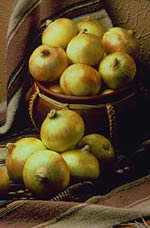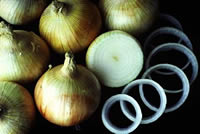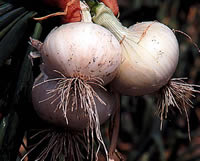Onion Transplanting Time
by Jerry Parsons, Ph.D.
Horticulture Specialist, Texas Agricultural Extension Service
in San Antonio
There are usually two ways to successfully grow
those jumbo stinkers called onions .
Seed can be planted in October or transplants can be planted
now. Onion seedlings which are small and rapidly growing often
don't survive when the cold temperatures occur. This means
that most onions will HAVE to be grown from transplants.
.
Seed can be planted in October or transplants can be planted
now. Onion seedlings which are small and rapidly growing often
don't survive when the cold temperatures occur. This means
that most onions will HAVE to be grown from transplants.
Plant onion transplants as soon as possible
to establish roots before optimum bulbing conditions occur.
The onion transplants should only be planted at least 4 inches
apart and one-inch deep (knuckle deep) or until all roots
are covered and the main crown is partially covered. For more
information and drawings, see:
http://plantanswers.com/Resources/Vegetable/E-514_onions.pdf
For best results and maximum sized onion bulbs,
certain procedures should be followed. Fertilization of onion
transplants is vital to success. Texas A&M research findings
indicate that onion growth and yield can be greatly enhanced
by banding phosphorus 2-3 inches below transplants at planting
time. This phosphorus acts as a starter solution which invigorates
their growth.
 Banding phosphorus, such as super phosphate
(0-20-0), 2-3 inches below the plant involves making a trench
or planting furrow 4 inches deep in the raised planting bed,
distributing one-half cup (one-half pound) of super phosphate
per 10 linear feet of row, covering the phosphate with 2 inches
of soil, and planting transplants. Once established, onion
plants should receive additional amounts of fertilizer such
as ammonium sulfate (21-0-0) as a sidedress application EVERY
three weeks -- use one cupful or one pound per 100 square
feet (10' X 10') of planting area.
Banding phosphorus, such as super phosphate
(0-20-0), 2-3 inches below the plant involves making a trench
or planting furrow 4 inches deep in the raised planting bed,
distributing one-half cup (one-half pound) of super phosphate
per 10 linear feet of row, covering the phosphate with 2 inches
of soil, and planting transplants. Once established, onion
plants should receive additional amounts of fertilizer such
as ammonium sulfate (21-0-0) as a sidedress application EVERY
three weeks -- use one cupful or one pound per 100 square
feet (10' X 10') of planting area.
Remember that onions require several months
to mature so plant them in a location which won't be needed
until June. Also, don't plant onions where they may be shaded
later by larger growing plants such as tomatoes or corn. Shading
decreases growth rate and, subsequently, bulb size.
 I have been told that "you can't make
a silk purse out of a sow's ear". Since sow's ears are
in short supply, I have never tried the silk purse conversion
but I DO know that the onion transplant you use will largely
determine the bulbing success. A quality transplant must be
used. Unfortunately, in the past, many of the onion plants
sold were diseased with pink root fungus, misnamed and of
poor quality. Texas Cooperative Extension horticulturists
have identified sources of true-to-name, disease-free, field-grown
transplants which are now available in local nurseries.
I have been told that "you can't make
a silk purse out of a sow's ear". Since sow's ears are
in short supply, I have never tried the silk purse conversion
but I DO know that the onion transplant you use will largely
determine the bulbing success. A quality transplant must be
used. Unfortunately, in the past, many of the onion plants
sold were diseased with pink root fungus, misnamed and of
poor quality. Texas Cooperative Extension horticulturists
have identified sources of true-to-name, disease-free, field-grown
transplants which are now available in local nurseries.
For optimum bulb size, onion plants must be
planted as soon as possible and judiciously fertilized throughout
the season as outlined above. When selecting onion plants,
the largest transplant may not be the best. If the stem of
onion plants are larger than a pencil when exposed to cold
temperatures, the onion will initiate and  produce
a flower. This flowering is termed as bolting. Most rapid
bolting is caused by temperatures of 40-45 degrees F. or below.
Fall seeded onion transplants are prone to bolting this spring
if onions with stems larger than a pencil were exposed to
warm fall temperatures, allowing excessive growth, followed
by low winter temperatures and slowed growth.
produce
a flower. This flowering is termed as bolting. Most rapid
bolting is caused by temperatures of 40-45 degrees F. or below.
Fall seeded onion transplants are prone to bolting this spring
if onions with stems larger than a pencil were exposed to
warm fall temperatures, allowing excessive growth, followed
by low winter temperatures and slowed growth.
Many gardeners believe that early removal of
the onion flower stalk will cause onion bulb enlargement but
this has not proven to be the case. Flowering causes a decrease
in bulb size as well as a central flower stalk which enhances
decay during storage. The onion bulbs which produce a flower
stalk may be large but they will be light-weight (one-half
the weight of a comparable size, non-flowered onion bulb)
and prone to decay. So give your neighbor "friends"
the large onion transplants --you keep and plant the less-than-pencil-size
transplants which can't bolt.
NOW is the time to act if you want to insure
a crop of big stinkers in June. Since the apple's reputation
has been tainted by the alar scare, maybe we can substitute
"an onion a day keeps the doctor away". Why not?
An onion a day keeps most people away! For more information
about the famous Texas onion and its relationship to every
other sweet onion in the world, see:
http://aggie-horticulture.tamu.edu/plantanswers/publications/onions/onionhis.html



